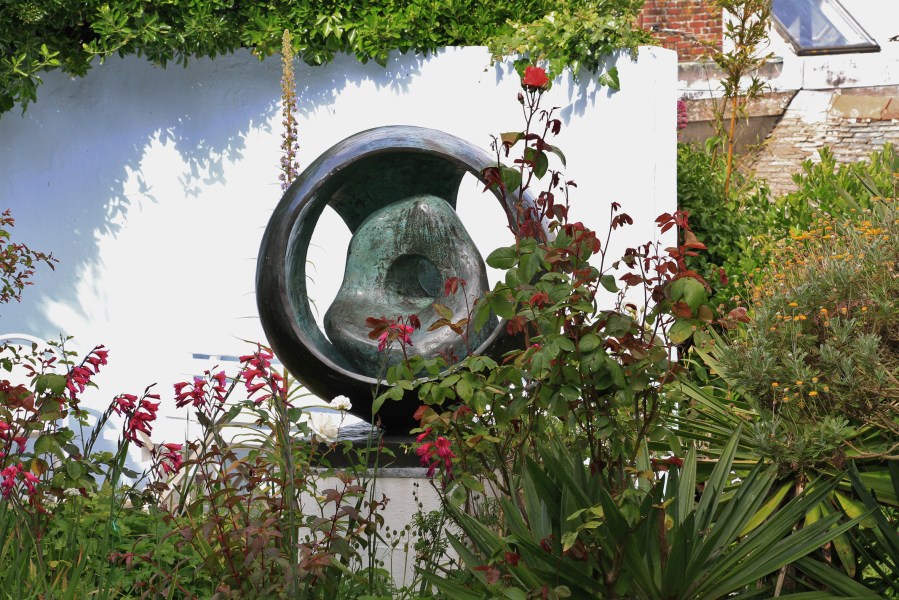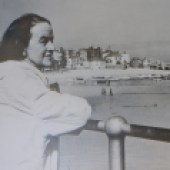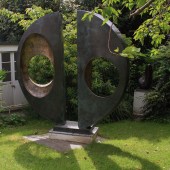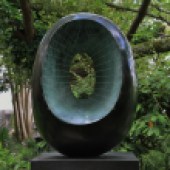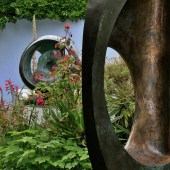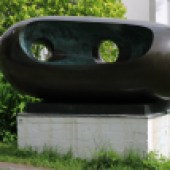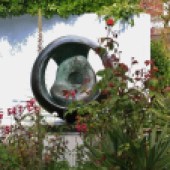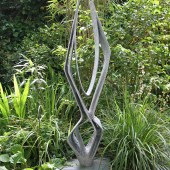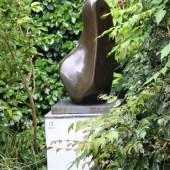The Barbara Hepworth Sculpture Garden in St Ives continues to evoke its famous creator 40 years after her death. Words and photographs: Emma Inglis
For the best part of the year, St Ives is a noisy place. The tightly packed houses and crowded streets teem with excited holiday-makers, the gulls scream overhead, the church clock peals to its own eccentric metre of time, dogs bark, and down by the harbour, a hum of traffic, people and boats reverberates well into the night. Yet at the bottom of a steep cobbled hill in the middle of town, behind cool white walls, there exists a peaceful haven of calm. This tranquil green oasis is Trewyn Studio and garden, where the sculptor Barbara Hepworth came to live and work in 1949 until her death 40 years ago.
A friendly rival of Henry Moore, with whom she studied at the Royal College of Art, Hepworth was one of the most important Modernist sculptors of the 20th century. Her work can be found all over the world, but the best examples are to be seen at Trewyn in St Ives: her beloved former home and garden in Cornwall. Now managed under the auspices of the Tate, the garden is crammed full of her distinctive forms with their undulating curves, ‘pierced eyes’ and hollow spaces.
To wander around Trewyn is a joy: the garden is not large – only around half an acre – but it perfectly combines the beauty of planting with Hepworth’s stone and bronze sculptures. Birds abound, as do the butterflies, darting in late spring between great clumps of pink and violet cinerarias, pelargoniums and regal lilies. The sculptures beg to be touched: some are big enough to enter. The shapes seem oddly familiar; forms snatched from nature, assuring, comforting – blending seamlessly into their surrounds. It all serves to remind you of Hepworth’s skill as an artist: some of her pieces are so fluid thatthey appear not made but rather to inhabit the landscape.
‘Finding Trewyn was a sort of magic’, Hepworth wrote of the studio. She had bought it at auction: the building and small garden had, at one time, belonged to Trewyn House next door. Originally intended as a place purely for work, within a year the modest studio had also become Hepworth’s home, when her marriage to the artist Ben Nicholson ended. There had been tensions in the relationship for some time. Before coming to Cornwall the couple had lived in London, and Hepworth had enjoyed a growing reputation among the artistic elite. But four small children – three of them triplets – and the outbreak of the Second World War in 1939 saw the family flee London for Cornwall and move to a house in Carbis Bay, next to St Ives.
ENDLESS INSPIRATION
In Carbis Bay, relations between the couple became increasingly strained as a frustrated Hepworth was forced to put domesticity before art. The break-down of the marriage and the move to Trewyn saw Hepworth throw herself back into her work – easier now that her children were at boarding school – and re-establish herself among the artistic cognoscenti.
At Trewyn, Hepworth could carve in the open air, in all seasons, and connect with the community, the sea and the rugged Cornish landscape. She was in her element. The ‘barbaric and magical’ countryside of West Penwith, with its rocky hills, fertile valleys and dramatic coastline, had a profound effect on her. Not only was it a glorious reminder of the Yorkshire landscape of her childhood and endlessly inspiring, it also provided her with one of her ‘greatest needs for carving: a strong sunlight and radiance from the sea which almost surrounds this spit of land’.
If you’re searching for a staycation hotspot for your Cornish break, try these top Cornwall hotels.
A LIVING CANVAS
But her new home and its surrounds were not just a canvas for her art, they were a canvas for activity. The garden was her first, and there was much to do. Hepworth called on the help of gardening friends to design it. Chief among these was the composer Priaulx Rainier, who had a small garden nearby and possessed an encyclopaedic knowledge of plants; and Will Arnold-Forster, author of Shrubs For The Milder Counties, who had created a beautiful garden at his home, Eagle’s Nest, in nearby Zennor. Together the three friends planned a garden that would be a showcase for Hepworth’s sculpture: a gallery en plein air (in the open air).
Turf replaced the old lawn; rockeries and terraces were built; a shallow pond was rescued and reconstructed; and a flurry of planting took place. Trewyn’s mild climate and sheltering walls were a bonus, encouraging the kind of planting familiar to Cornish gardens: fuchsias, camellias, ferns and magnolias, as well as the more exotic ginkgo biloba, a Chusan palm, and a clump of bamboo with magnificent thick green stems. The sculptures were placed on plinths in viewing spaces, and set off by plants liked by Hepworth for their form or leaf texture. There was no scarcity of buyers: they came and went all the time.
Today, a heady scent of leaf and flower accompanies the steady stream of visitors that troop along the maze of overgrown narrow paths in this exotic paradise where plant and form coexist in perfect harmony. Sunlight dapples the downy underplanting and glints through the leaves of thickly growing shrubs to reveal half-hidden bronzes, weathered stone and a pond speckled with cherry blossom. Shadow patterns break and reform across the garden. A curled-up cat dozes in the sinuous arc of a sculpture, delighting all who see it.
The paths arrive at a summer house (with daybed, where Hepworth would snooze), a greenhouse and at Hepworth’s workshop: peer in and you can see the tools she liked to use, as well as her dusty overalls and a stack of plaster models from which bronzes would be cast.
Although Hepworth continued to work until her death, at the end of her life she was becoming increasingly frail. In 1966, a year after she was made a Dame Commander of the British Empire, Hepworth was diagnosed with cancer of the throat, and a fractured hip hindered her mobility one year later. But her sudden end, in May 1975, aged 72, still came as a shock: she died in a fire at Trewyn Studio, probably caused by her dropped cigarette. The garden – and its contents – was left undamaged.
Her family carried out her wishes to turn the house and garden into a museum, and in 1980 its management was taken over by the Tate. While many gardens learn to march to a different tune when their makers move on, the garden at Trewyn remains little changed. It continues to evoke its famous creator, maintaining its uncomplicated tranquillity and its bond of plant and form. The sculptures are just as Hepworth left them. A few more shrubs might have found their way into the garden – added by nurseryman and gardener John Anderson in the Eighties – but, for the most part, the garden people see today is the same one that Hepworth so loved.
For more stories on artists by the coast, see the ‘Arts and Crafts’ section on our website and the regular ‘Creative Corner’ features in the magazine.

